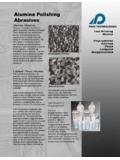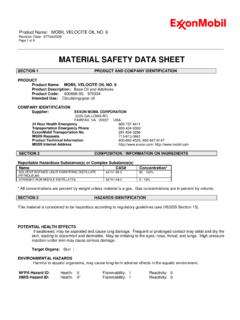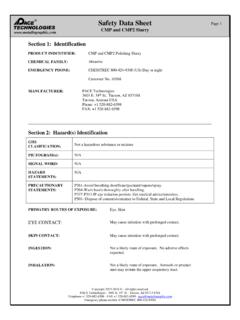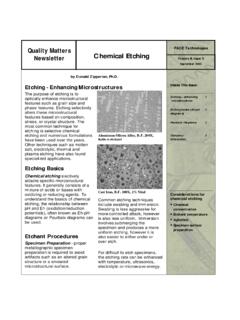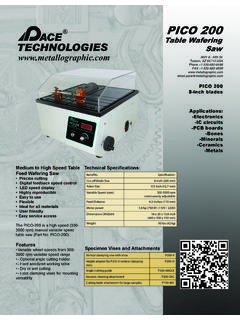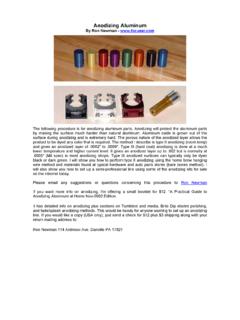Transcription of Quality Matters Colloidal Silica PACE Technologies …
1 By Donald Zipperian, March 2003 PACE Technologies Colloidal Silica polishing Abrasives polishing with Colloidal Silica Alternate with finer diamond suspensions for improved metal polishing CMP abrasive for polishing advanced ceramics and minerals Inside this issue: Colloidal Silica polishing Abrasives 1 Ceramics and Mineral polishing 1 Metal polishing 2 Application of Colloidal Silica 2 Company Information 3 Colloidal Silica polishing Volume II, Issue 3 Quality Matters Newsletter Colloidal Silica polishing suspensions are unique because they provide both a dispersing action as well as a chemical mechanical polishing (CMP) action.
2 It is effective as an additive for the intermediate diamond polishing of metals and is also the best polishing abrasive for eliminating subsurface and surface damage in ceramics because of its CMP polishing action. Colloidal Silica polishes are chemically stabilized to produce a nearly perfect Ceramics and Minerals At higher pH values Colloidal Silica is held in nearly perfect suspension by the electrochemical repulsive forces of the fine particles themselves. This chemical balance also eletrochemcially attacks the surface of a ceramic or mineral surface to form a thin reacted layer on the specimen surface.
3 This reacted layer can then be removed via the mechanical action of the polishing cloth or another abrasive ( diamond). polishing rates and surface finishes are significantly better for ceramics and minerals as compared with straight mechanical abrasives such as diamond. Thus the highest removal rates and the most reliable polishing action for removing both surface and subsurface damage for ceramics and minerals is via chemical mechanical polishing with Colloidal Silica . Continued on Page 2 suspension . Typical pH values for stabilized Colloidal Silica are greater than Colloidal Silica polishing solutions have up to 50% solids and yet maintain their suspension properties.
4 The average particle size for Colloidal Silica polishing suspensions range between um and um. Colloidal Silica polishes can also have additives that minimize the effect of particle aggregation of crystallization. Silicon Nitride Polished with 6, 3, 1, , and um diamond (5 minutes each step) Silicon Nitride Polished with 6, 1 um diamond and Colloidal Silica , 5 minutes each step) Page 1 Continued from page 1 Enhanced polishing rates can be achieved for ceramics by increasing the chemical contribution from the Colloidal Silica polish. As with other exothermic chemical reactions, the chemical contribution can be enhanced by increasing the temperature of the polishing action.
5 Increasing the polishing pressure, increases the friction between the polishing cloth, Colloidal Silica and the specimen and thus enhances the chemical contribution. Colloidal Silica abrasives produce excellent surface finishes, however care must be taken to avoid crystallization of the suspension . Quality Matters - Volume I1, Issue 3 Ceramics and Minerals Continued Application of Colloidal Silica The recommended procedure for polishing with Colloidal Silica is to initially wet the polishing cloth with the Colloidal Silica and then to slowly drip the suspension onto the polishing cloth.
6 At the end of the polishing cycle, it is recommended that water be applied continuously to the polishing cloth for 10-15 seconds prior to completion of the polishing step. This aids in removing the fine particles which may be chemically bonded to the specimen surface. This reacted layer can also be removed by polishing with an ammonia water and hydrogen peroxide solution for several seconds. Alumino-Silicate glass ceramic, 200x (DIC) as polished. SiSiC ceramic, 400X (DIC) as polished. Colloidal Silica makes an excellent intermediate diamond polishing extender, dispersant or lapping lubricant for fine diamond polishing of metals.
7 In addition, for some metals such as aluminum, the high pH of the polish can also enhance the polishing rate. It is not normally recommended that Colloidal Silica be used for final polishing of metals because the Colloidal Silica has a tendency to crystallize as the water in the solution evaporates. This crystallization can lead to very hard and large particles, which can produce relatively large scratches in soft metals such as aluminum, austenitic stainless steels and copper. Metal polishing PACE Technologies is an innovative and fast-growing company with a full line of metallographic and precision surface finishing products.
8 We were the first metallographic company, in 1998, to offer online purchasing through our web site ( ). We continue to lead the market with customized web pages and CD s to meet our customers needs. PACE Technologies offers metallographic testing consumables and equipment, including: abrasive blades, diamond wafering blades, compression and castable mounting compounds, grinding abrasives, polishing pads, diamond abrasives, final polishing alumina and Colloidal Silica abrasives. As leaders in the field, we seek to provide technical information and innovations to the metallographer.
9 Our Arizona research facility focuses primarily on the development of new products and processes for both the metallographic and industrial precision surface finishing markets. Our web page offers the most complete metallographic web site for specimen preparation procedures and specimen preparation training, as well as links to other useful web sites. We have also just completed a technical and etchant database. Featuring thousands for etchants, this easy-to use database is the most comprehensive etchant database available on CD. At PACE Technologies , our goal is customer satisfaction.
10 We offer user-friendly technical and ordering information, instant communications and transparent pricing. Our employees practice a customer-first philosophy every day and it is this customer dedication which has made PACE Technologies today s leader in the supply of precision polishing consumables and equipment. PACE Technologies 200 Larkin Dr. Wheeling, IL 60090 Phone: 847-520-4193 Fax: 847-520-4194 Email: Where Quality Meets Value For more information visit our web site at Quality Matters Volume II, Issue 3 Page 3
